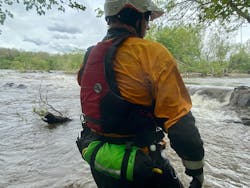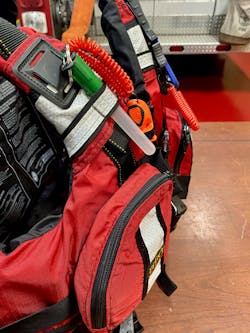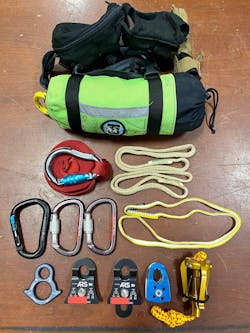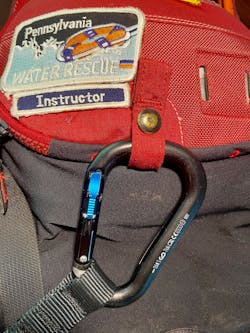Swiftwater rescuers must perform many tasks under pressure and in a short period of time. They require mission-specific equipment. Their personal flotation devices (PFDs) become “tactical vests,” carrying what they need to accomplish their mission.
How swiftwater rescuers’ PFDs are organized plays a role in the rescuers’ safety. If a rescuer is swept into moving water, the equipment that individual carries can increase greatly the chances of entrapment and possible drowning.
When looking to outfit personnel, much can be learned from how the paddling community (kayak, raft, canoe, stand up paddleboard) operates when rescuing a fellow paddler. Individuals who spend their days running whitewater are exposed consistently to the environment and its hazards. This is where the “clean principle” originates.
The clean principle
The clean principle was born out of the “clean line principle,” referring to the general need to minimize any loop in rope or webbing that could snag and lead to a potentially fatal entrapment. Rope and moving water don’t mix, but several operations that are critical to swiftwater rescue require rope. Loops in rope and webbing only should be large enough to accommodate a carabiner. Smaller loops lessen the risk of a snag and prevent someone from putting their hand through the loop. The clean principle focuses on an individual’s PPE, specifically the PFD, to identify and to eliminate as many entrapment hazards as is possible.
There are a variety of PFDs on the market. Each offers a range of options. Swiftwater rescuer PFDs should be U.S. Coast Guard Type III or Type V. Type III PFDs are work vests that provide sufficient flotation. They usually have pockets to store gear.
Type V PFDs are similar to Type IIIs—including in regard to pockets—but are used in swiftwater rescue. They have a removable ring and releasable strap around the PFD. The Type V requires additional training for attaching ropes to the ring, for proper deployment of the triglide buckle and emergency procedures that relate to cases in which the triglide becomes jammed.
There are specialized PFDs that are purpose-built for specific tasks. NFPA-compliant rescue PFDs have higher buoyancy. As a result, they generally are larger than their counterparts. (Rescue PFDs that are used for whitewater kayaking and rafting are smaller—which means less buoyancy—but they are more comfortable for paddling and swimming.)
Whichever type of PFD that you choose, it must be sized for you. Proper fit, trimming excess length off of the releasable strap and user comfort, are vital for the PFD to perform properly.
Emergency responders usually have an entire apparatus to carry rope, rigging bags, ring buoys, hose-inflation kits, Carlson boards, boats, motors, rope gun, etc. What do these individuals need to carry on their person during a swiftwater rescue?
Paddlers carry what they need on their PFD and in their kayak or canoe. They generally follow a 4-3-2-1 guideline: four carabiners, three pulleys, two Prusiks and one piece of 10–20-foot-long webbing. The underlying idea to this guideline is, “You have yours, I have mine and we can solve most issues together.”
Rescuers can modify this to a 3-2-1 rule: three carabiners, two Prusiks and one piece of webbing.
A few other pieces of gear that can be carried on the PFD should include a knife and a whistle. Optional gear that can be carried can include a pair of nitrile gloves (stored inside of a plastic bag), a backup folding knife and a chemical light stick.
Gear that’s kept on the PFD should be kept in pockets as much as possible. That said, bigger pockets are more likely to catch on an object. They also add girth to the individual and can create a “shelf” to maneuver around while swimming. Having a well-fitting PFD, without bulky pockets or too much extra equipment, is key. Keeping your PFD light and snag-free helps to prevent a bad day.
Attachment points
Most PFDs come with attachment points for knives, whistles and lights. Some PFDs only have one such spot, while others have as many as five or six. Just because an attachment point is there doesn’t mean that you must use it. Some of these points are in the worst places on the vest, such as on top of a pocket, where they stick out and increase the circumference of the user. Attaching gear should be fixed to a position that’s least likely to create a snag hazard, generally up on the shoulders.
If you decide to attach gear to the outside of your PFD and you use a dummy cord, then plastic bungee keychains are preferable for the dummy cord. The bungee keeps the cord tight to the PFD and will break if it snags on an object.
Clothesline, paracord and other small-diameter ropes could become entangled and must be cut while trapped underwater. The breaking strength of these small-diameter cords is greater than most people believe. In fact, these cords might not break free without being cut. If the rope that’s keeping you trapped underwater is the same as the one that’s attached to your knife, you are unlikely to survive.
A throw bag is a valuable tool for rescuers and should be kept with you as you perform operations. However, carrying a throw bag can be cumbersome as well as dangerous if it isn’t attached correctly.
All too often, throw bags are attached with carabiners, webbing straps and buckles to the exterior of the vest. Attaching a bag in this way might be convenient, but it creates a large entanglement hazard and is an obstruction while swimming. Attaching a throw bag to a quick-release belt, where the bag rests under the PFD, negates the aforementioned issues. If a waist-mounted throw bag isn’t available, the bag should be attached to the quick-release strap of the Type V PFD so that it can be released if it becomes entangled on anything.
Tethers: risk vs. reward
Another option for Type V PFDs are tethers, also known as cow tails or leashes. Tethers originated in the whitewater industry to retrieve gear after a kayaker “went for a swim.” Kayakers who are in their boat can hook the tether to a drifting kayak and tow it into an eddy that’s nearby to them.
Rescuers have adopted these tethers for use in swiftwater rescues. They can be used as a travel restraint, to prevent water entry by securing a rescuer to an anchor point that’s on shore. Another use of tethers is for rescuers to have an easily reachable connection point while tethered to a rope.
Bungee tethers are preferred. If a bungee tether is used during a direct-contact rescue, it can absorb some shock that a webbing or cordage tether can’t. A bungee tether also is preferred because it stays tighter to the body and creates less of a snag hazard, such as improperly sized lengths of cordage or webbing can create.
Utilizing a long length of webbing or cordage as a tether should be avoided, because it could increase the opportunity for entanglement. A few commercially available tether keepers handle the excess length, but in rough current, the tether still can deploy inadvertently from the keeper.
Carabiners that are situated on the end of the tether should have a locking gate and should be secured to a specific point on the PFD, where it can release when the triglide buckle is deployed. Don’t attach the carabiner to a sewn piece of webbing or other hard point: The tether won’t release properly if the carabiner can’t release from the vest.
Most of the time, tethers are underutilized and create a hazard on the PFD. Documented cases from the paddling community report how paddlers drowned because their tether became entangled in objects.
High-buoyancy Type V PFDs might not have the proper attachment points for a carabiner to release when the triglide buckle is deployed. Furthermore, some tethers are sold with a nonlocking carabiner, which has a chance of attaching to objects that are in your operating environment, such as a rope that’s inside of a raft, chain-link fence and thin metal handrails.
Preventing emergencies
As rescuers, you are tasked with many responsibilities. Having your PPE help, rather than hinder, you expedites the accomplishment of those tasks.
You can learn a great deal from different water sport communities and apply that to rescue operations. Put into practice, the clean principle of swiftwater rescue can prevent an emergency from occurring.
Andrew McIntyre will present “Urban Water Rescue Considerations” at Firehouse Expo. To register, visit firehouseexpo.com.
About the Author
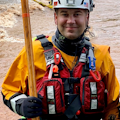
Andrew McIntyre
Andrew McIntyre has been in the fire service since 2003, serving in both career and volunteer departments, on urban search and rescue teams, and as an instructor. Further work as a whitewater river guide, ski patroller, scuba divemaster and mountaineer brings a wide range of knowledge and experience. McIntyre is a U.S. Marine Corps. infantry veteran.
